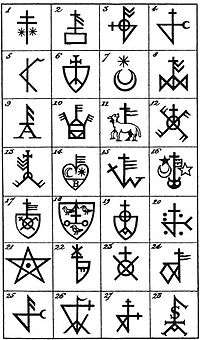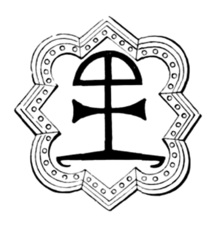Merchant's mark



Merchants' marks are as old as the sealings of the third millennium BCE found in Sumer that originated in the Indus Valley.[1] Impressions of cloth, strings and other packing material on the reverse of tags with seal impressions indicate that the Harappan seals were used to control economic administration and trade.[2][3] Amphorae from the Roman Empire can sometimes be traced to their sources from the inscriptions on their handles. Commercial inscriptions in Latin, known as Tituli picti, appear on Roman containers used for trade.[4]
Symbolic merchants' marks continued to be used by artisans and townspeople of the medieval and early modern eras[5] to identify themselves and authenticate their goods. These distinctive and easily recognizable marks often appeared in their seals[6] on documents and on products made for sale. They are often found on headstones and in works of stained glass,[7] brass[8] and stone, serving in place of heraldic imagery, which could not be used by the middle classes.[9] They were the precursors of hallmarks, printer's marks[10] and trademarks.
To manage the risks of piracy or shipwreck, merchants often consigned a cargo to several vessels or caravans; a mark on a bale established legal ownership and avoided confusion. Early travellers, voyagers and merchants displayed their merchant's marks as well to ward off evil. Adventurous travellers and sailors ascribed the terrors and perils of their life to the wrath of the Devil. To counter these dangers merchants employed all sorts of religious and magical means to place their caravans, ships and merchandise under the protection of God and His Saints.

One such symbol combined the mystical "Sign of Four" with the merchant's name or initials. The "Sign of Four"[11] was an outgrowth of an ancient symbol adopted by the Romans and by Christianity, Chi Rho (XP), standing for the first two letters of Christus in Greek letters; this was simplified to a reversed "4" in Medieval times. The evolution of this symbol is shown in M. J. Shah's article.[12] The "Sign of Four" is called the "Staff of Mercury" (Caduceus) in German and Scandinavian literature on house marks.[13]
The joint stock company or limited liability company was another way to reduce a merchant's risks of loss of ships and merchandise from dangerous voyages and travel. By royal charter a monopoly was assured and a merchant's personal liability was limited to the amount of his own investment. If a voyage succeeded the gains accrued to all of the investors in proportion to their invested capital shares. Modern institutions, corporations and trademarks, find some of their origins in these symbolic and legal devices for limiting physical and pecuniary risks.
The East India Company's Merchant's Mark


When the East India Company was chartered by Elizabeth I, Queen of England in 1600 it was still customary for each merchant or Company of Merchant Adventurers to have a distinguishing mark which included the "Sign of Four" and served as a trademark. The East India Company's mark was made up from a '+', a '4' and the initials EIC.
This mark forms the central emblem displayed on the Scinde Dawk postage stamps.[14] Also, it was a central motif of the East India Company's coinage.[15]
See also
| Wikimedia Commons has media related to Merchants' marks. |
- Cylinder seal
- Titulus pictus
- Early modern Europe
- Emblems
- Seals
- Monogram
- Symbols
- Brand
- Trademark
- House mark
Further reading
- Elmhirst, Edward Mars, Merchants' Marks, ed. Dow, Leslie, Harleian Society, 1959
References
- ↑ Seals were used to make impressions in wet clay as a means of sealing shipments of goods. D. H. Kelley and B. Wells, "Recent Progress in Understanding the Indus Script", Review of Archaeology. Vol. 16, No. 1 : 15-23.(1995).
- ↑ Asko Parpola, "Study of the Indus Script", p. 52. Paper read at the 50th ICES Tokyo Session on 19 May 2005 in Tokyo.
- ↑ Geoffrey Cook, "A Unicorn Seal", The Ancient Indus Civilization (on line).
- ↑ J. Theodore Peña, Roman Pottery in the Archaeological Record, p. 106. Cambridge U. Press (2007) ISBN 0-521-86541-7
- ↑ Sylvia L. Thrupp, The Merchant Class of Medieval London (1300-1500). U. Chicago (1948).
- ↑ http://medievalwriting.50megs.com/decoration/seal6.htm Medieval Writing
- ↑ http://www.cvma.ac.uk/content/books/browne/browne2.htm Corpus Vitrearum Medii Aevi - Browne's Chapel
- ↑ http://medievalwriting.50megs.com/decoration/seal6.htm| Medieval Writing
- ↑ "merchant's mark", House of Names
- ↑ http://spencer.lib.ku.edu/sc/ptrsmark.shtml University of Kansas Libraries. Kenneth Specer Research Library. Special Collections.
- ↑ D. Christison, "The Carvings and Inscriptions on the Kirkyard Monuments of the Scottish Lowlands; particularly in Perth, Fife, Angus, Mearns, and Lothian," in Proceedings of the Society of Antiquaries of Scotland, Volume 36 (1901-02): Fig. 114, p. 117.
- ↑ http://web.archive.org/web/20091027143019/http://www.geocities.com/mjshah.geo/scinde/scinde.html Scinde District Dawks - The Premier Stamps of Asia
- ↑ C. G. Homeyer: Die Haus- und Hofmarken, Berlin 1870, Tuve Skånberg: Glömda gudstecken. Från fornkyrklig dopliturgi till allmogens bomärken (2003) under Creative Commons BY-NC-ND 2.5 licens Lund 2003, Anders Bjønnes : Segltegninger fra hyllingene i Norge 1591 og 1610, Oslo 2010.
- ↑ "Scinde District Dawks - The Premier Stamps of Asia", excerpted by M. J. Shah from Manik Jain and S.B. Kothari, The Silver Key to The Golden Treasure of Indian Philately.
- ↑ East India Company coin 1791, half pice, as illustrated.